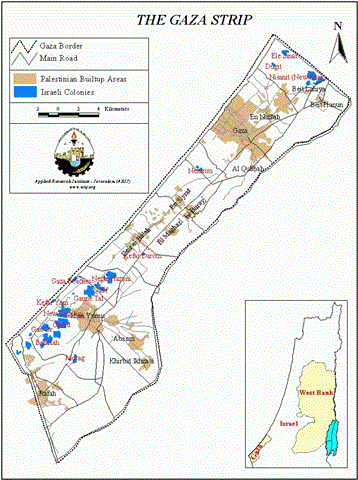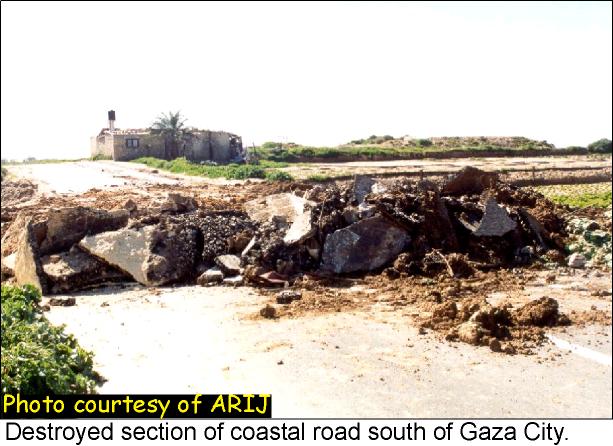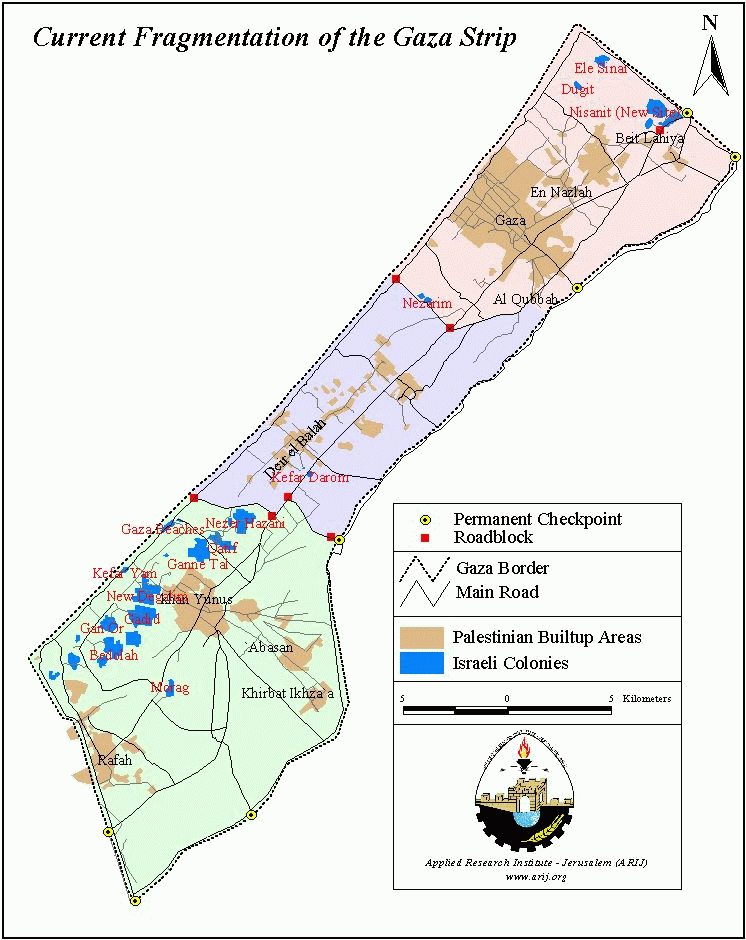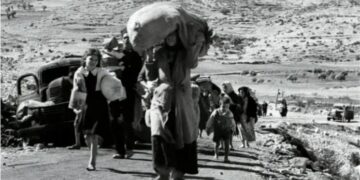The Gaza Strip is a narrow piece of land located on the Mediterranean Sea to the southwest of Israel on the border with Egypt; see map. The Strip is 45 km long and is between 6 and 12 km wide. The total area of the Strip is 363.8 km². Approximately 1,087,000 Palestinians inhabited this small strip of land in 1999, making it one of the most over-crowded areas in the world with a population density of 3000 people per km². The over crowdedness of the Gaza Strip is further amplified when one knows that the Palestinians control only 70% of it. So in effect the population density is over 4000 people per km². In comparison, the remaining 30% under Israeli control houses 6,500 settlers giving a population density of 60 people per km2. The percentage of people under the age of 15 is around 50%. Over 75% of the population is refugees, half of whom live in Gaza's eight refugee camps.
The Palestinians in the Gaza strip have often suffered the worst that the Israeli occupation has to offer, in terms of physical proximity to the occupying forces and as victims of the harshest of its methods. In the context of this already stressful situation the Israeli occupation has stepped up its siege on Gaza since the beginning of the Al-Aqsa Intifada. This has caused a rapid deterioration in all aspects of life for Palestinians in Gaza. This case study tries to highlight the situation in the sectors of health, education and labor.
With the exception of brief, sometimes only partial re-openings, all points into and out of Gaza have been closed since early October of 2000. This includes all commercial passages, the international passage into Egypt and the Gaza International Airport.
This state of siege has been heightened by a closure of roads within Gaza. Since January 2, 2001 the Israeli occupation forces have closed both Salah El-Din Street and the coastal road, the two roads that connect the Strip from north to south. In addition, most of the smaller branch roads have also been closed. The methods used to carry out this internal closure policy include not only the strengthening of the network of military checkpoints, but also the physical destruction of the roads themselves; see photo. There are sections of the narrow beach that Palestinians may resort to in order to get around roadblocks, but in doing so they risk being shot at. As a result of this internal closure, the Gaza strip has been cut into three separate areas: the southern area including Rafah and Khan Yunis, the middle area including Deir al Balah, and the northern area including Gaza City and Jabalya; see map.
Due to the internal and external closure of Gaza, and in violation of their basic human rights, Palestinians are not permitted to reach health facilities, schools, workplaces, fields, family members and homes that lie in another area of the partitioned Gaza Strip.
The Health Sector
The health situation in Gaza has deteriorated significantly in recent months as health facilities have been burdened with thousands of injuries due to Israeli attacks. At the same time the medical facilities have been reduced in their capabilities to serve the population. Palestinian hospitals, in need of medical equipment and supplies at the best of times, have been further strained by the closure of the Gaza Strip border that has made delivery of medical equipment very difficult or impossible. In addition to medical equipment, patients have been prevented from leaving Gaza in order to receive medical attention not available there. Patients who had already left before the closure have been prevented from returning home.
The restriction of movement caused by the internal closure has also had serious effects on the Palestinians of Gaza. Access to hospitals is severely restricted, especially for residents of the middle area, whose residents must go to either the Nasser hospital in Khan Yunis or the Shifa' hospital in Gaza City. Doctors, nurses, and other hospital employees are equally unable to travel freely to their workplaces, resulting in understaffed facilities. As is the case with other vehicles, ambulances are unable to cross into other areas of the Gaza Strip, interfering with emergency care. In addition, the Israeli military and settlers have attacked ambulances and their crews.
The following are examples of Israeli violations of Palestinian health rights during one single day in the Gaza Strip. On January 2, 2001:
-
Israeli occupation forces positioned at Netzarim junction, to the south of Gaza City, prevented the passage of a pregnant woman to Shifa' hospital in Gaza City. Mariam A'amer El-Akhras was in need of a Caesarian operation that could not be performed in the middle area due to the lack of medical equipment in nearby clinics.
-
A Palestinian ambulance transporting patients Rajab El-Sa'an and Safeya El-Kurd, both 70 years old, was prevented from reaching Shifa' hospital in Gaza City and forced back to Deir El-Balah.
-
Occupation forces prevented the entry of a Palestinian Ministry of Health vehicle loaded with foodstuffs and oxygen for 24 premature babies at Nasser hospital in Khan Yunis despite advanced coordination with the Israelis for its passage. The following day it was allowed to pass, but only after being fired upon by the army and then waiting for over four hours.
The Education Sector
The partitioning of Gaza into three parts has caused major setbacks for educational institutions and the education of their students. Thousands of students have been unable to reach their schools and hundreds of faculty members and staff of these institutions have been equally unable to reach their workplaces. Most of the universities in the Gaza Strip are located in Gaza City, in the north. But 50% of the students and 60% of the professors are from the southern area of the Strip. The blockades between the north and south pose a critical interference to the education of students and the administration of the schools. Students who go to universities in the West Bank or in other countries are prevented from leaving the Strip due to the external closure. Similarly, students already at universities outside of Gaza are unable to return and see their families.
Schools and their students have also suffered direct damage and injury due to the shooting and shelling of the Israeli occupation forces. In many cases, repairing the schools has been impossible due to lack of funds.
The Labor Sector
The external and internal closures enforced in the Gaza Strip have severely limited the ability of Palestinian workers to reach their workplaces, causing a sharp rise in unemployment. Factories and stores have had to close because employees cannot reach them.
Before the Gaza border was closed in late September 2000, about 24,000 Palestinians regularly went into Israel to work. Approximately 48,000 additional workers were employed on a day-to-day basis. Employment in Israel is the main source of income for the Palestinian labor force. The average daily wage of a Palestinian laborer in Israel is about US $27.50. Therefore, the 72,000 regular and irregular Palestinian laborers collectively lose about US $1,980,000 daily due to the closure.
Table 1: Daily Losses to Palestinian Laborers from Gaza in Israel
|
Type of Employment |
# of Workers |
Daily Wage |
Collective Daily Losses |
|
Regular |
24,000 |
$27.50 |
$660,000 |
|
Day-to-day |
48,000 |
$27.50 |
$1,320,000 |
|
Total |
72,000 |
$27.50 |
$1,980,000 |
This brief summary of the health, education, and labor sectors in the Gaza Strip gives some idea of the hardships Palestinians have faced there since the closure began in late September. Similar deterioration has occurred across all levels of the economy and society, resulting in a sharp decline in the quality of life of residents of the Strip.
[1] According to PCBS estimates:
This report was written with data compiled by the Al-Mezan Center for Human Rights and the Palestinian Center for Human Rights.
Prepared by:
The Applied Research Institute – Jerusalem














